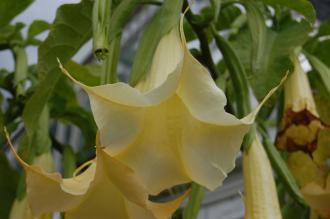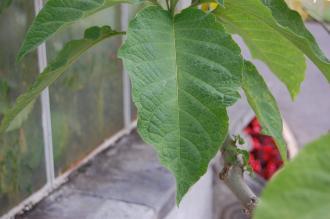
Brugmansia suaveolens (02/07/2016, Kew Gardens, London)
Position: Full sun to light shade
Flowering period: Late spring to late summer
Soil: Moist, well drained
Eventual Height: 5m
Eventual Spread: 3m
Hardiness: 10a, 10b, 11, 12
Family: Solanaceae
Brugmansia suaveolens is a semi evergreen shrub or small tree with an open habit. Its mid green leaves are ovate with entire margins, up to 25cm long and 15cm across. Its fragrant white/ yellow/ pink flowers are trumpet shaped, pendulous and up to 30cm long.

Brugmansia suaveolens Flower (02/07/2016, Kew Gardens, London)
Brugmansia suaveolens, commonly known as Angel’s Trumpet or Angel’s tears, is native to the coastal region of south east Brazil. In its native habitat it grows in rainforests along river banks and forest margins. Brugmansia suaveolens is synonymous with Datura suaveolens. It should be noted all parts of this plant are toxic. This plant is considered to Extinct in the Wild according to the IUCN Red List of Threatened Species.
The etymological root of the binomial name Brugmansia is named after Sebald Justin Brugmans (1763-1819), a Dutch professor of natural history. Suaveolens is derived from the Latin suavis meaning ‘sweet’ or ‘attractive’ and oleo menaing ‘smell’.
The landscape architect may find Brugmansia suaveolens useful as an attractive container grown shrub with very attractive fragrant flowers. It should be noted this plant should be protected from frost during the winter months.

Brugmansia suaveolens Leaf (02/07/2016, Kew Gardens, London)
Ecologically, Brugmansia suaveolens flowers are attractive to pollinating insects, including moths.
The Royal Horticultural Society have given Brugmansia suaveolens their prestigious Award of Garden Merit in 1993.
Brugmansia suaveolens prefers moist, humus rich, fertile, well-drained soils. It tolerates most pH of soil. This plant dislikes dry soils.
Brugmansia suaveolens requires little maintenance. This plant should be watered freely and fertilised regularly.

Landscape Architecture

